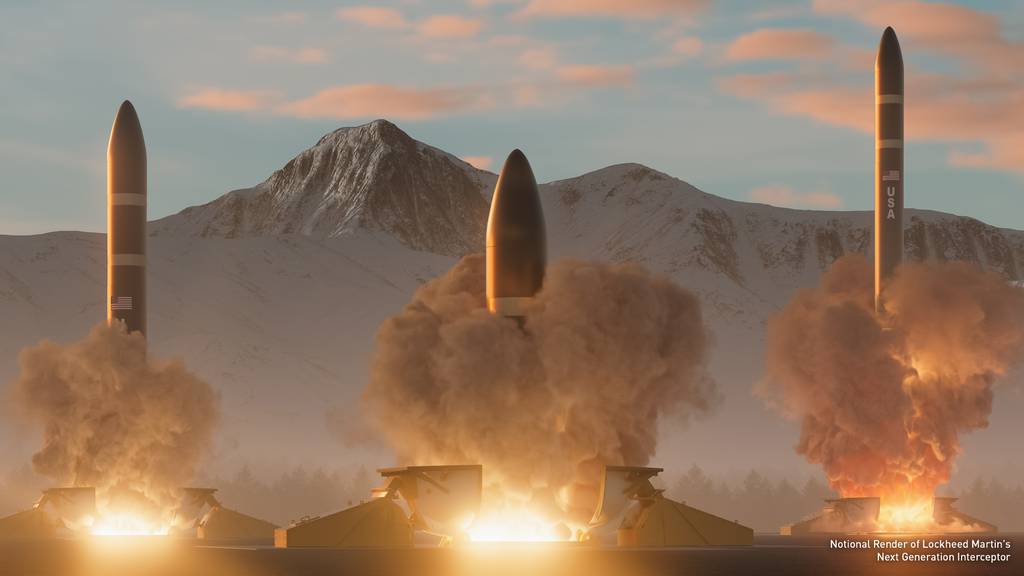
Nearly a year prior to a deadline for two competing teams to reach a critical design review phase in the development of a Next-Generation Interceptor for homeland defense, the Missile Defense Agency chose Lockheed Martin to move forward rather than carry both teams through the next phase of technology development.
Lockheed and its Aerojet Rocketdyne partner completed the preliminary design review at the end of September. A Northrop and RTX team passed through the same design review at the end of January.
Both teams received technology development contracts from MDA in 2021.
The critical design review phase was expected to take roughly a year. Now just Lockheed will continue development of the Next-Generation Interceptor, or NGI, through that phase, followed by all-up round qualification, and integration into the Ground-Based Midcourse Defense (GMD) system and into flight testing, according to a April 15 MDA statement.
A production and emplacement contract would follow, according to the agency, which supports an initial operational capability for NGI no later than the fourth quarter of fiscal 2028.
“MDA is confident in this decision based on the technical maturity of the solutions, objective contractor-provided performance data, technical rigor in the design development process and early testing built into the program from the onset,” the agency said in the statement.
“The American defense industry is one of our country’s greatest strengths, and having to decide between the two different design approaches was very difficult,” Lt. Gen. Heath Collins, the agency’s director said. “That said, in our effort to Go Fast and Think Big, we are very confident in our decision to go with Lockheed Martin.”
During the preliminary design review, both teams believed they could move quicker than an emplacement deadline of 2028, indicating they both saw ways to get interceptors into silos by fiscal 2027.
The agency did not offer a direct reason why it decided to end the competition before the end of the critical design review in its statement. But, the previous MDA director, Vice Adm. Jon Hill, indicated that the Defense Department had options on how long to stay in a competitive phase for the NGI program.
Maintaining competition through the PDR and down-selecting after is “a Department of Defense best practice,” the MDA said in the statement, and “allows MDA to focus its resources on a single solution going forward.”
MDA added, “additional risk is mitigated based on the technical maturity of the solutions; the technical rigor and testing built into the upfront design and development process; and the discovery of technical issues earlier on an accelerated schedule with time and funding available to implement remedies/mitigations.”
The GMD system was designed to protect the U.S. homeland from intercontinental ballistic missiles from Iran and North Korea. There are 44 GBIs in the ground with the majority in silos at Fort Greely, Alaska, and the rest at Vandenberg Space Force Base in California. The current interceptors aren’t equipped to counter a missile that could contain multiple kill vehicles or decoys that make the defeat process more complicated, defense officials have said.
NGI is the result of the Pentagon canceling in August 2019 its Redesigned Kill Vehicle program – which would have upgraded the GBI to be able to pursue more complex threats. That program struggled with insurmountable technical issues resulting in delayed schedules and cost increases. Raytheon, a subcontract for Boeing, was the developer of the RKV program.
Roughly eight months after the cancellation of the RKV program, MDA launched the new interceptor push.
The companies were designing the new interceptor using digital methods meant to speed up the design process, enabling the build of hardware and starting testing earlier in the process. Both also invested in establishing deeper roots in Huntsville, Alabama, to more easily coordinate with MDA on the effort.
Lockheed broke ground in 2022 on a new Missile System Integration Lab in Huntsville exclusively for the development of NGI and will be co-located with the company’s engineering team. The company is spending $16.5 million to build the new 25,000-square-foot facility, which opened in 2023.
Northrop began building two large facilities in Huntsville as well to house the core NGI team. A combined software factory between Northrop and Raytheon as well as systems engineering was housed there in those facilities, which were also up and running in 2023.
Author: Jen Judson
Source: DefenseNews



